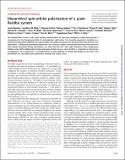Hierarchical spin-orbital polarisation of a giant Rashba system
Date
25/09/2015Author
Grant ID
UF120096
EP/M023427/1
EP/I031014/1
Keywords
Metadata
Show full item recordAbstract
The Rashba effect is one of the most striking manifestations of spin-orbit coupling in solids and provides a cornerstone for the burgeoning field of semiconductor spintronics. It is typically assumed to manifest as a momentum-dependent splitting of a single initially spin-degenerate band into two branches with opposite spin polarization. Combining polarization-dependent and resonant angle-resolved photoemission measurements with density functional theory calculations, we show that the two “spin-split” branches of the model giant Rashba system BiTeI additionally develop disparate orbital textures, each of which is coupled to a distinct spin configuration. This necessitates a reinterpretation of spin splitting in Rashba-like systems and opens new possibilities for controlling spin polarization through the orbital sector.
Citation
Bawden , L , Riley , J M , Kim , C H , Sankar , R , Monkman , E J , Shai , D E , Wei , H I , Lochocki , E , Wells , J W , Meevasana , W , Kim , T K , Hoesch , M , Ohtsubo , Y , Le Fevre , P , Fennie , C J , Shen , K M , Chou , F C & King , P 2015 , ' Hierarchical spin-orbital polarisation of a giant Rashba system ' , Science Advances , vol. 1 , no. 8 , e1500495 . https://doi.org/10.1126/sciadv.1500495
Publication
Science Advances
Status
Peer reviewed
ISSN
2375-2548Type
Journal article
Description
This work was supported by the Engineering and Physical Sciences Research Council, UK (grant nos. EP/I031014/1 and EP/M023427/1), the Ministry of Science and Technology in Taiwan (project no. MOST-102-2119-M-002-004), NSF (grant nos. DMR-0847385, DMR-1120296, and DMR-1056441), the Office of Naval Research (grant no. N00014-12-1-0791), and TRF-SUT Grant RSA5680052. P.D.C.K. acknowledges support from the Royal Society through a University Research Fellowship. H.I.W. acknowledges support from the NSF IGERT (Integrative Graduate Education and Research Traineeship) program (DGE-0903653) and the NSF Graduate Research Fellowship under grant no. DGE-1144153. L.B. and J.M.R. acknowledge studentship funding from EPSRC through grant nos. EP/G03673X/1 and EP/L505079/1, respectively.Collections
Items in the St Andrews Research Repository are protected by copyright, with all rights reserved, unless otherwise indicated.

